Why Sri Lanka is the Perfect Adventure Destination
Sri Lanka’s growing popularity as an adventure hotspot isn’t just a coincidence. It’s a combination of factors that make it uniquely suited for thrill-seekers. Here’s why:
Diverse Landscapes

Though it is a somewhat tiny island, Sri Lanka boasts an incredible range of settings inside its boundaries. A few hours will allow you to go from palm-fringed beaches to foggy mountain tops, deep jungles, and barren plains. This geographical variety directly translates into an incredible spectrum of adventure sports. The coastal areas are ideal for water activities; the middle highlands have difficult trekking and climbing possibilities. White-water rafting and canyoning find perfect conditions along the rivers cutting through the island. With so many endemic kinds of plants and animals, Sri Lanka’s unique biodiversity gives every outdoor activity even more thrills.
Year-Round Journey
Sri Lanka has plenty for thrill-seekers year-round, unlike many adventure sites that have a restricted season. Its two separate monsoon seasons, the “Yala” monsoon (May to August), which influences the Southwest, and the “Maha” monsoon (October to January, which influences the Northeast, help to explain this. This implies that another area of the island is enjoying the sunlight and ideal weather for adventure while one is suffering from significant rains. For instance, the Yala monsoon marks the height of the surfing season in Arugam Bay (east coast). In contrast, the ideal period for kitesurfing in Kalpitiya (West Coast) is during the Maha monsoon or between May and October. Arranging your trip during these seasons increases your chances of fantastic weather.
Rich Society and Past:
Adventure in Sri Lanka offers a chance to really experience a rich and old culture in addition to adrenaline. Many adventure sports find their locations close to cultural attractions and historical monuments. One may see old temples in addition to a climb to Adam’s Peak, a holy peak. Alternatively, fly hot air balloons over the Cultural Triangle, a UNESCO World Heritage site, to gain a bird’s-eye perspective of historic cities such as Sigiriya and Polonnaruwa. Your trip gains a significant depth by interacting with nearby towns, enjoying traditional food, and encountering Sri Lankan friendliness.
Cost-effectiveness
Sri Lanka has outstanding value for money when compared to other well-known adventure sites all across the globe. Usually more reasonably priced are meals, transportation, and lodging; this will help you to stretch your money farther and enable more enjoyment. Although some pursuits, including hot air ballooning, might be somewhat costly, there are lots of low-cost choices including hiking, surfing, and solo national park exploration. For experienced explorers as well as those wishing to try new sports without going broke, Sri Lanka’s affordability appeals.
Top Thrill-Seeking Activities in Sri Lanka
Let us now go right into the core of the matter: the exhilarating sports that make Sri Lanka an adventure heaven.
White-Water Rafting from Kitulgala
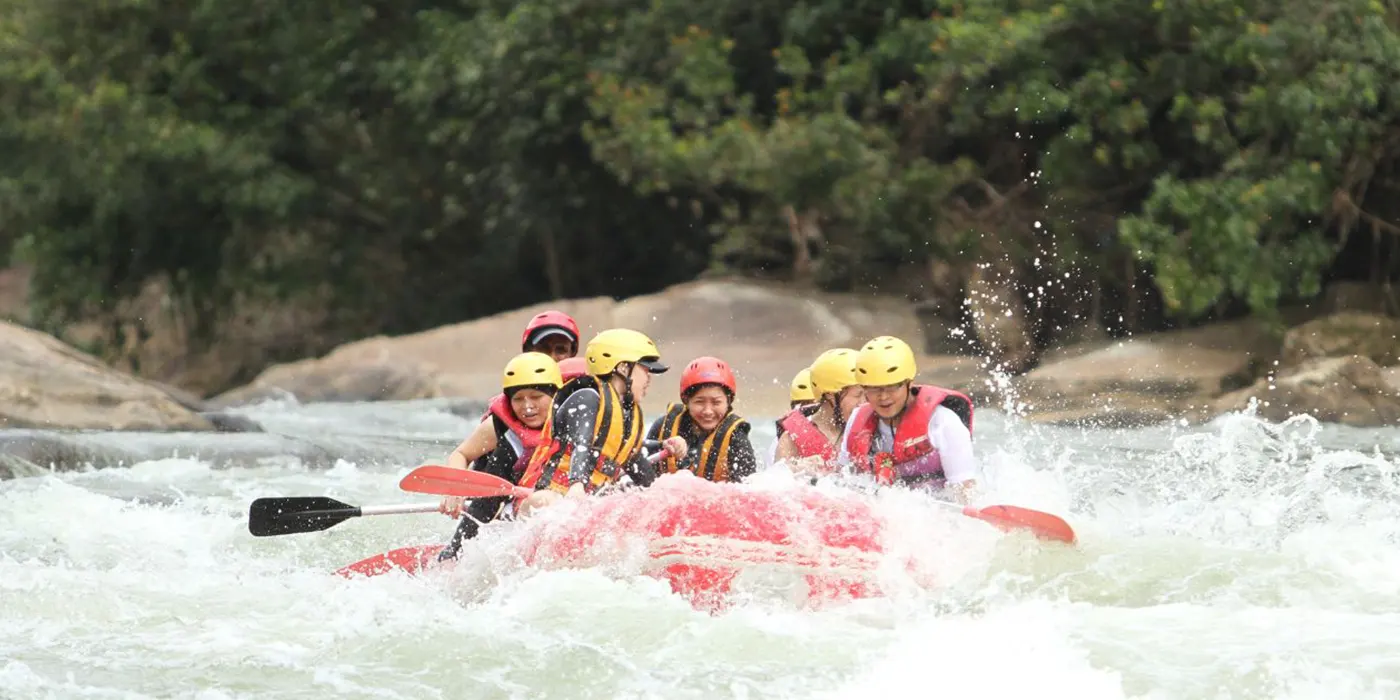
Unquestionably, Sri Lanka’s white-water rafting center is Kitulgala, a little village tucked away in the verdant hill region. Both novices and expert rafters would find the Kelani River, which runs through Kitulgala, appropriate given its range of rapids from Grade 2 to Grade 4. The landscape is breathtaking, with towering cliffs, cascading waterfalls, and the river meandering through thick rainforests.
- Rapids: You’ll negotiate a sequence of rapids under titles like “Virgin’s Breast,” “Butter Crunch,” and “Killer Fall don’t worry, they’re more fun than they sound!
- Environment: Look for animals along the riverbanks including perhaps even a water monitor, monkeys, and birds.
- Safety: Reputable tour companies have all required safety gear including helmets, life jackets, and seasoned guides.
- “The Bridge on the River Kwai”: Kitulgala was the site of filming for the well-known 1957 film; you still see traces of the bridge.
Tour operators: Many of the tour companies in Kitulgala provide rafting excursions, often mixed with other pursuits such as jungle hiking or canyoning. Particularly in the busy season, it’s advisable to reserve in advance.
The ideal time to visit is: Though Kitulgala may be rafted year-round, the optimum water levels usually fall between May and December. See your trip operator about the water level outside this period.
Kitulgala Rafting Rapids
|
Rapid Name |
Grade |
Description |
|
Virgin’s Breast |
2 |
Gentle, suitable for beginners. |
|
Butter Crunch |
3 |
More challenging, with larger waves and rocks. |
|
Head Chopper |
3 |
Narrow passage requires precise maneuvering. |
|
Killer Fall |
4 |
The most challenging rapid, with a significant drop. |
Surfing in Arugam Bay
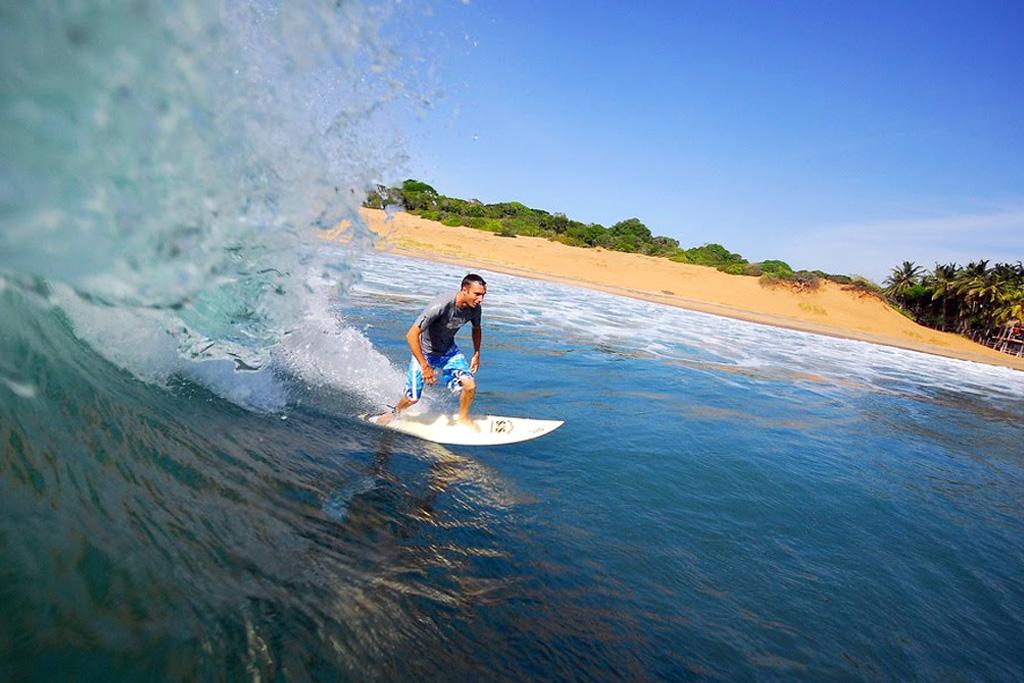
Considered a world-class surfing destination, Arugam Bay on Sri Lanka’s east coast often ranks among the best surf places in Asia. This laid-back seaside town has ideal waves, warm water, and a thriving surf culture.
The breaks:
- Main Point: Long right-hand point break most known for providing rides up to 400 meters. Fit for intermediate to experienced surfers.
- Perfect for novices and long boarders, a smaller, calmer break is peanut farm.
- Elephant Rock: Another very difficult wave across a rocky reef. Perfect for more seasoned surfers.
- Whiskey point: Another often used surf location with a right-hand point break
The best surfing season at Arugam Bay is from April to October when the southwest monsoon generates regular swells. Usually falling between two and six feet, the waves throughout this period include occasional more significant surges.
Rentals and surf schools: Along Arugam Bay’s main road sits several surf schools and board rental businesses. Whether your level of knowledge is zero or you want to advance, you will find seasoned teachers and a large selection of boards from which to draw.
Arugam Bay presents more than just surfing beyond the waves. You might unwind on the shore, visit surrounding lagoons, arrange a wildlife safari in Kumana National Park, or enjoy the cool vibe.
Best Time to Visit: April to October for the best waves.
Hiking to Adam’s Peak (Sri Pada)

Respected by many religions, Adam’s Peak, also known as Sri Pada’s sacred footprint, is a prominent peak in central Sri Lanka. Although the climb is physically taxing, the spiritual value and amazing morning views from the top make for a wonderful trip.
- Religious Significance: At its peak the mountain features a holy footprint-shaped depression. Buddhists say it’s the footprint of Buddha; Hindus say it’s Shiva’s; Muslims say it’s Adam’s; Christians say St. Thomas’s. This mutual respect fosters a special pilgrimage mood.
- The ascent is: Depending on your degree of fitness, the climb consists in ascending approximately 5,500 steps a difficult task usually requiring two to four hours. Usually starting in the early hours of the morning (around 2:00 AM), most pilgrims trek to reach the top in time for sunrise.
- Sunrise Views: At sunrise, the panoramic vues from the top are rather amazing. The “Spectre of the Brocken” is the phenomena wherein the sun creates a triangle shadow of the mountain onto the surroundings as it rises above the clouds.
Practical Advice:
- Start Time: Begin your climb between 2:00 AM and 3:00 AM to catch the sunrise.
- What to Wear: Dress in layers, as it can be cold at the summit, especially before dawn. Wear comfortable hiking shoes.
- What to Bring: Bring water, snacks, a flashlight or headlamp, and a raincoat or poncho (especially during the rainy season).
- Fitness Level: Be prepared for a strenuous climb. Take breaks as needed.
Best Time to Visit: The pilgrimage season runs from December to May. During this time, the weather is generally drier, and the path is illuminated. Outside of this season, the climb is still possible, but the weather can be unpredictable, and the path may not be lit.
Data:
- Elevation: 2,243 meters (7,359 feet)
- Steps: Approximately 5,500
- Climbing Time: 2-4 hours (average)
- Distance: Approximately 7km
Rock Climbing in Ella
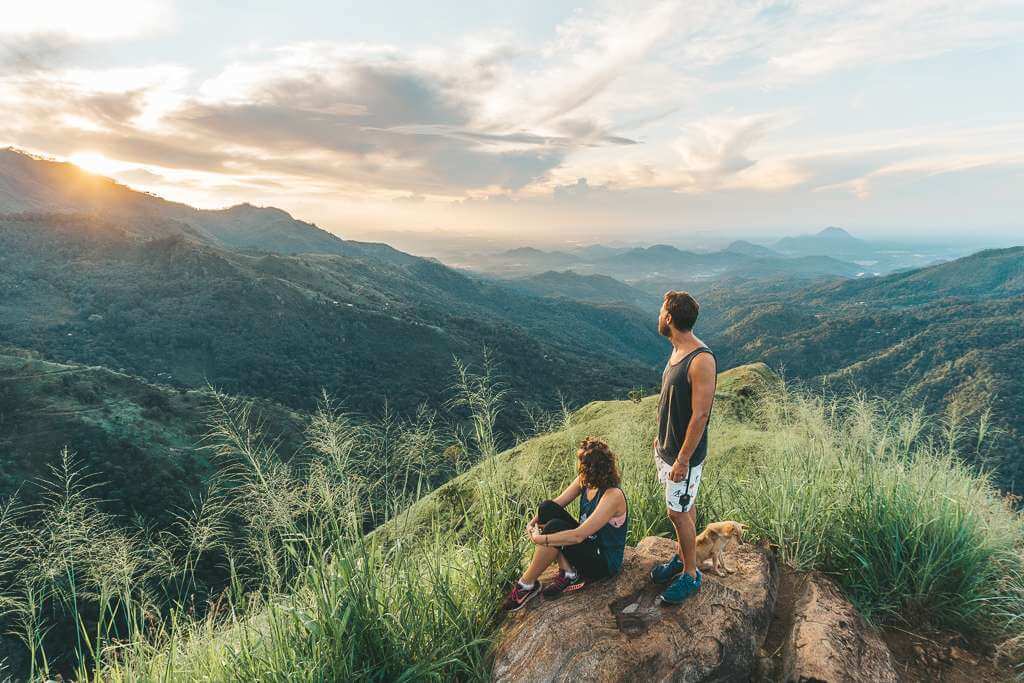
Rising as a rock climbing destination, Ella is a little village tucked away in hill region of Sri Lanka is getting more and more famous. Testing your climbing ability in this exciting location with its towering cliffs and breathtaking vistas is rather challenging.
The most famous climbing site, Ella Rock provides several paths for varying degrees of ability. Although Ella granite itself is more of a difficult climb, there are already set climbing paths on the granite face.
Apart from Ella Rock, the nearby region offers several climbing sites with bouldering chances. Information about these less-known locations can be supplied by local tour companies and guides.
Skill Levels: Many climbs in Ella call for some prior climbing expertise, however certain paths are appropriate for novices (with appropriate supervision and equipment). Particularly if you are not familiar with the region, climbing under the direction of a professional guide is very essential.
vistas and Scenery: The climbing routes provide truly amazing vistas. Panoramic views of Ella Gap, Little Adam’s Peak, and the adjacent tea estates will be yours.
Safety: Throughout rock climbing, always give safety first priority. Use the correct tools helmets, harnesses, and ropes among other things. Ascend under the direction of a competent guide who understands the paths and can guarantee your security. Mountains have fast changing weather, hence be ready.
The dry months from December to March and from May to September—are the ideal times to visit Ella for rock climbing.
Kitesurfing in Kalpitiya
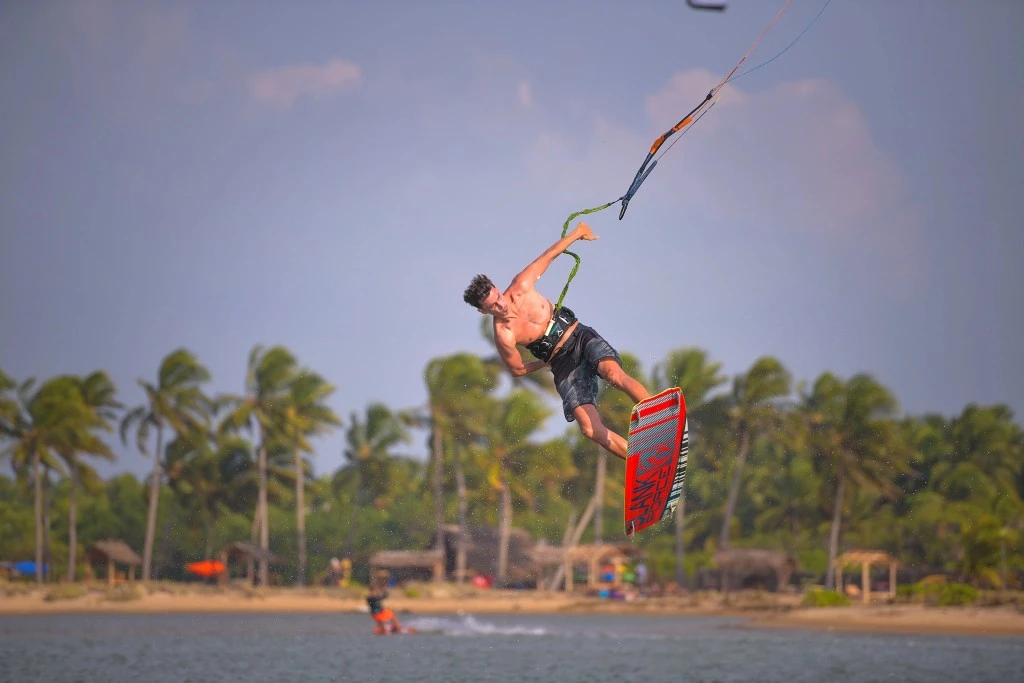
Rising on a peninsula in northwest Sri Lanka, Kalpitiya is among the greatest kitesurfing spots in Asia. Beginning and expert riders will find the perfect playground created by its regular breezes, shallow lagoons, and flat-water conditions.
Kalpitiya gains from two separate wind seasons. Often topping 20 knots, the summer season (May to October) brings strong, southwesterly winds. The winter, from December to March, delivers much milder, northwesterly winds. Kalpitiya is a consistent kitesurfing site because of its almost year-round wind.
Lagoons abound in the Kalpitiya peninsula, including the lesser Puttalam Lagoon and the sizable Kalpitiya Lagoon. These lagoons provide significant levels of shallow water, ideal for learning and stunt performance. For beginners, the shallow water also offers a sense of safety.
Operating in Kalpitiya, many kitesurfing schools and rentals run courses at all levels, equipment rentals, and downwind tours. Most schools are situated on the Kappalady and Kandakuliya seashore. Common qualified instructors are IKO, International Kiteboarding Organization.
Far beyond Kitesurfing: Kalpitiya provides chances for dolphin and whale viewing, touring the surrounding Wilpattu National Park, and local fishing while you’re not on the water.
Best Time to Visit:
- Summer Season (May to October): Strongest and most consistent winds (southwesterly).
- Winter Season (December to March): Lighter winds (northwesterly), still suitable for kitesurfing.
Wind Conditions in Kalpitiya
|
Month |
Wind Direction |
Average Wind Speed (knots) |
Best For |
|
May – Oct |
Southwesterly |
18-25+ |
All levels |
|
Dec – Mar |
Northwesterly |
12-18 |
Beginners, Freestyle |
Hot Air Ballooning Over the Cultural Triangle
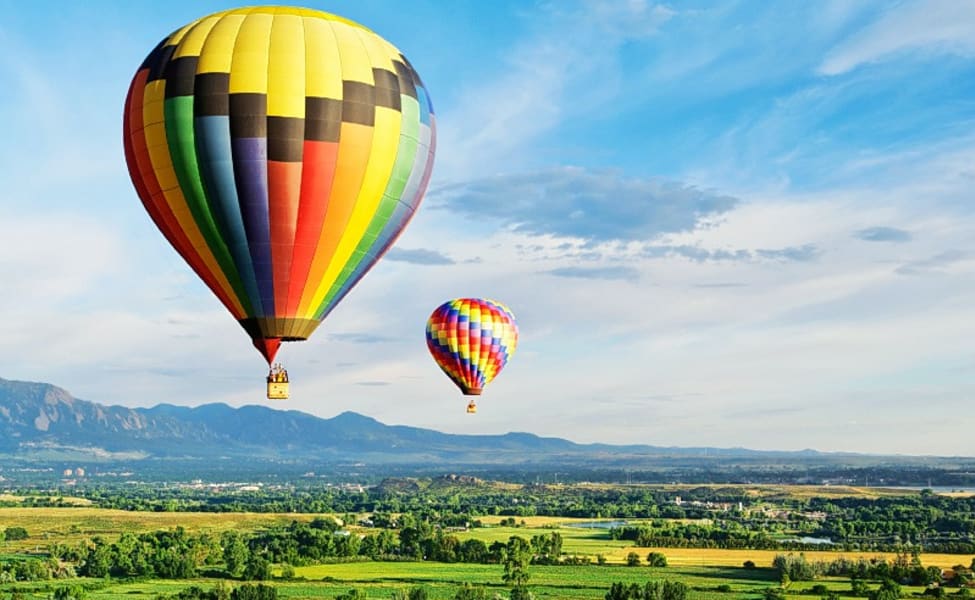
Take to the heavens in a hot air balloon and fly above Sri Lanka’s Cultural Triangle for a very distinctive and fascinating journey. This trip provides amazing panoramic views of famous sites, rich scenery, and historic towns.
Usually occurring around daybreak, when the air is quiet and the light is magnificent, flights You will get unmatched views of Sigiriya Rock Fortress, Dambulla Cave Temple, old reservoirs (tanks), and large areas of forest as you softly glide above the earth. The quiet, interrupted only by the sporadic burner explosion, accentuates the tranquilly of the experience.
You will see the famous “Lion Rock,” towering majestically out of the lowlands.
- Dambulla: The Golden Temple together with its cave system.
- Ancient Reservoirs: The several man-made lakes supporting centuries-spanning Sri Lankan civilization.
- Wildlife: From above, you could even see elephants or other animals.
- Lush landscapes including woods, rolling hills, and rice terraces.
Reservation and What to Anticipate: A premium experience, hot air ballooning calls for advance scheduling. Flights rely on the weather and may be canceled should the circumstances become unsuitable. Usually lasting an hour, flights see passengers rewarded to a champagne toast upon landing.
The greatest period for hot air ballooning in the Cultural Triangle is during the dry season, usually running from November to April. The sky are clearer and the winds are quieter during this period.
Diving and Snorkeling in Hikkaduwa, Pigeon Island, or Kirinda
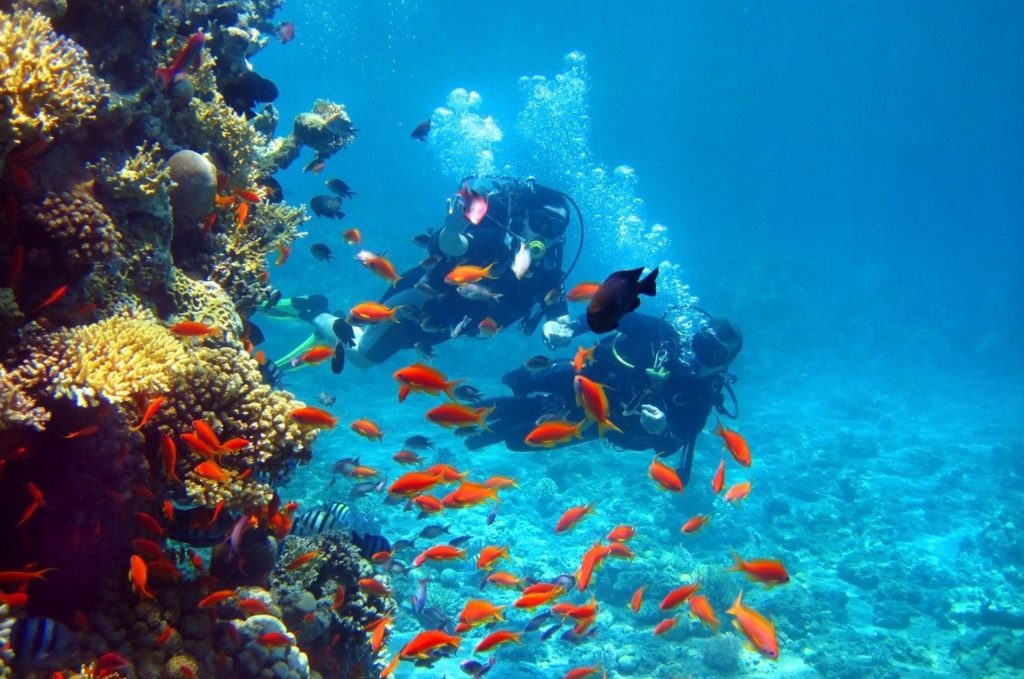
- Diving and snorkelers will find Sri Lanka a fulfilling location with its varied underwater environment. Every degree of underwater aficionado will find something from amazing shipwrecks to colourful coral reefs.
- Popular and well-known diving and snorkeling site Hikkaduwa on the southwest coast Known for its coral paradise, it features a range of vibrant fish, turtles, and other aquatic life. The region boasts many diving operators as well as snorkelling rental stores.
- Renowned for its immaculate coral reefs and rich marine life, Pigeon Island National Park is situated east coast off the shore of Nilaveli (next to Trincomalee). With shallow, clean waters and a great possibility of spotting blacktip reef sharks (harmless), turtles, and a brilliant assortment of reef fish, it’s thought of as one of the greatest locations for snorkelling in Sri Lanka.
- On the south coast, Kirinda provides access to the Great and Little Basses Reefs. Stronger currents make diving these reefs more difficult, but they also provide an opportunity to view more marine species like groupers, rays, and sharks. Experienced divers would find diving here most appropriate.
- Many of the diving operations along the shore provide guided dives, snorkelling tours, PADI (Professional Association of Diving Instructors) certification courses, Selecting a respectable operator with well-kept equipment and seasoned teachers is crucial.
Marine Life: Sri Lanka’s waters are home to a wide variety of marine life, including:
- Turtles (five different species)
- Colorful reef fish (angelfish, butterflyfish, parrotfish, etc.)
- Blacktip reef sharks
- Moray eels
- Rays
- Dolphins and whales (seasonal)
Visibility and Best Times to Dive:
- Southwest Coast (Hikkaduwa): Best from November to April. Visibility can range from 10-20 meters.
- East Coast (Pigeon Island): Best from April to September. Visibility can be excellent, up to 20-30 meters.
- South Coast (Kirinda): Best from November to April. Visibility can vary depending on currents.
Canyoning in Kitulgala
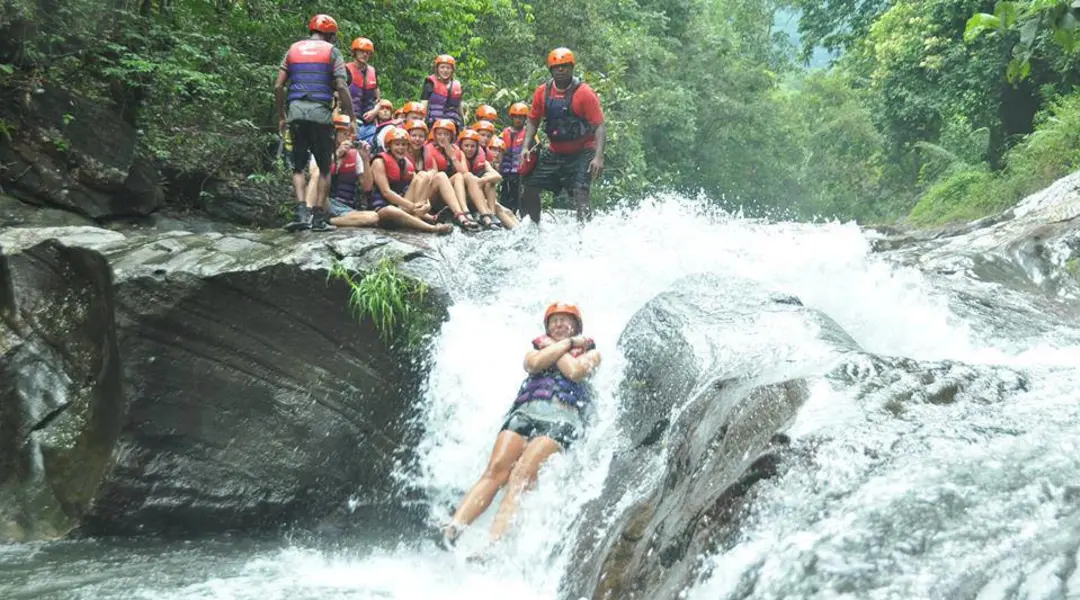
Already well-known for white-water rafting, Kitulgala also presents an exciting journey in canyoning. This sport consists in abseiling (rappelling), sliding down natural water slides, and leaping into rock pools across a canyon.
The Experience: Canyoning in Kitulgala explores secret waterfalls and unique rock formations deep into the jungle. Combining swimming, climbing, and hiking, this physically demanding yet immensely fulfilling activity
Using ropes and harnesses, abseiling—also known as rappelling—descends waterfalls and cliffs.
- Sliding: Sliding down smooth-rock made natural water slides.
- Jumping: Into deep rock pools under direction from seasoned teachers.
- Swimming: Negotiating portions of the canyon via swimming.
Safety: Only seasoned and certified guides should conduct canyoning. Reputable travel companies have all required safety gear available: helmets, life jackets, and harnesses. They also offer guidance on correct jumping and abseiling procedures.
Several of the same tour operators who provide white-water rafting in Kitulgala also provide canyoning adventures. Booking with a firm that values safety and has a strong history is really vital.
Though it may be done year-round depending on river levels, the optimum period for canyoning in Kitulgala is normally from May to December, same as in white-water rafting. See your travel operator for advice.
Physical Criteria: Canyoning calls both a respectable degree of fitness and water confidence. Though you should be at ease with heights and in natural surroundings, you do not need to be an exceptional swimmer or climber.
Wildlife Safaris in Yala or Udawalawe National Park
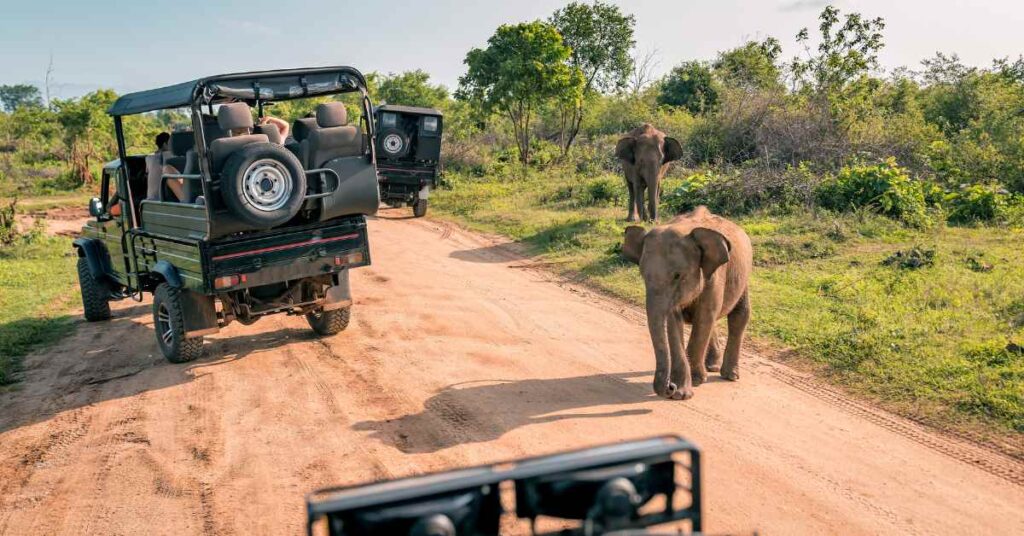
Though not a classic “thrill-seeking” sport in the same sense as rafting or climbing, a wildlife safari in Sri Lanka provides a unique form of excitement: the thrill of seeing wild creatures in their natural habitat. Sri Lanka features a great variety of species, and its national parks offer great chances for seeing them.
Yala National Park: Celebrated for its high leopard population, Yala is the most well-known national park in Sri Lanka. One of the greatest locations worldwide to see these elusive large cats is here. Yala also boasts elephants, sloth bears, crocodiles, deer, and a great range of birds.
Udawalawe National Park is especially well-known for its big elephant count. You practically certainly will encounter elephants on a safari here. The park boasts other animals as well, including deer, water buffalo, and many bird species.
Usually carried out in open-top jeeps, Jeep safaris let for unhindered vistas.
Safari providers supply seasoned drivers and guides informed on the fauna and habits of the park.
Safaris are ideal in the early morning or late afternoon when animals are most active.
- Respectful Wildlife Viewing: Steer clear of upsetting animals and keep a safe distance from them.
- Selecting a safarian operator: Choose a respectable safari provider that gives ethical travel first priority along with animal welfare. Seek out operators who respect park rules, steer clear of animal crowding, and help with conservation projects.
- Yala: Generally speaking, the dry season—from February to June—is the optimum period for leopard sightings as the foliage is less thick.
- Udawalawe: Though year-round visitation is possible, greater view comes from the dry season—May through September.
Advice for Optimizing Possibilities of Animal Visibility:
- Be Patient: Viewing wildlife calls for patience. Demand does not show animals.
- Pay attention to Your Guide; they are well knowledgeable about animal locations and behavior.
- Be Quiet: Steer clear of loud noises meant to scare off animals.
- Bring binoculars; these will help you to identify creatures far away.
- Wear neutral colors; steer clear of vivid apparel meant to frighten animals.
Planning Your Adventure Trip to Sri Lanka
To make the most of your thrill-seeking adventure in Sri Lanka, a little planning goes a long way. Here’s a breakdown of essential considerations:
Visas and Entry Requirements
Most nationalities require a visa to enter Sri Lanka. You can typically obtain an Electronic Travel Authorization (ETA) online before your trip. The ETA is usually valid for 30 days. Check the official website of the Department of Immigration and Emigration Sri Lanka (https://www.immigration.gov.lk/) for the most up-to-date visa requirements and any COVID-related travel restrictions. Requirements can change, so it’s crucial to verify the information before you travel.
Getting Around
There are several ways to get about Sri Lanka, each having benefits and drawbacks.
- Trains: Particularly for hill country travel that is, the well-known Kandy to Ella route the train network is picturesque and reasonably priced. Trains can, nonetheless, be packed and sluggish.
- Buses: Covering practically every area of the island, buses are the most often used public vehicle. Though quite affordable, they can be packed and uncomfortable especially on extended trips.
- Tuk-Tuks: For quick trips inside towns and cities, three-wheeled auto-rickshaws are perfect. Agree on a cost before you set out your adventure.
- Private Drivers: Particularly for travel between cities or between several sites, hiring a car with a driver is a more pleasant and practical choice. Though more costly, this gives you freedom and lets you stop at fascinating sites along the road.
- Taxis are easily found in larger cities.
Advice: Combining many means of transportation is usually the best way for an adventure trip involving several sites. You may, for instance, ride a train across the hill country, pay a few days for a driver to tour the Cultural Triangle, and rely on tuk-tuks for local travel.
Conclusion
Sri Lanka really lives up to its standing as a newly discovered adventure heaven. Every kind of thrill-seeker will find an amazing experience there from its breathtaking variety of settings, exciting activities, rich culture, and reasonable price range. Adventure beckons in Sri Lanka from the white-water rapids of Kitulgala to the ideal surf of Arugam Bay, from the holy pinnacle of Adam’s Peak to the undersea marvels of Hikkaduwa. This island country offers everything to inspire your adventurous spirit regardless of your level of experience with adrenaline activities or curiosity about them. So start packing, get ready for thrills, and get set to discover Sri Lanka’s wild side. Beginning your Sri Lankan journey right now, start organizing This is your guide to identify Sri Lanka’s top thrills for adventurers!
Keywords and Meta Data:
Adventure activities in sri lanka with price, One day
adventure trip in Sri Lanka, Adventure Parks in Sri Lanka, Adventure activities
in Colombo, Adventure camps in Sri Lanka, Sri Lanka adventure tours,Scuba
diving in Sri Lanka, Adventure tourism, adventure activities in sri lanka, one
day adventure trip in sri lanka, adventure parks in sri lanka, adventure
activities in colombo, adventure camps in sri lanka, sri lanka adventure tours,
scuba diving in sri lanka, adventure tourism, sri lanka activity holidays,

- [email protected]
- +94 71 29 700 51


